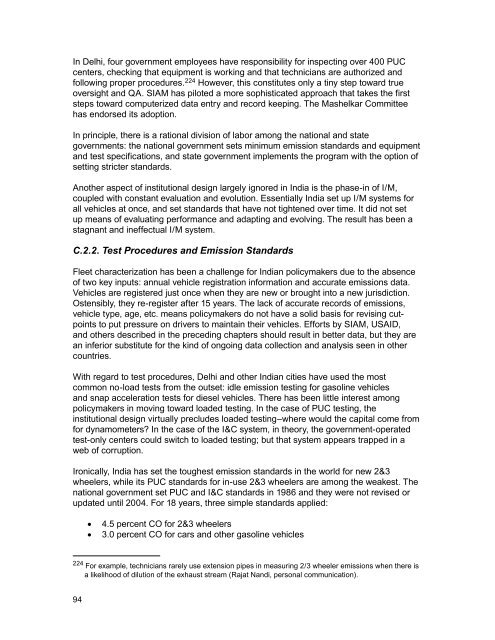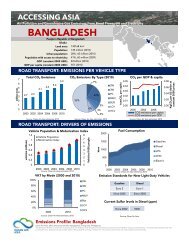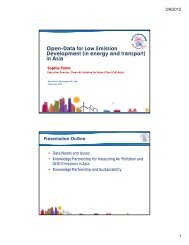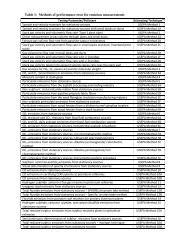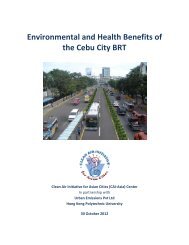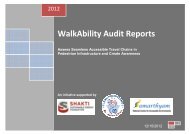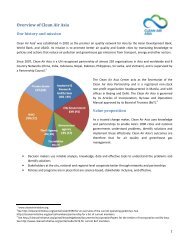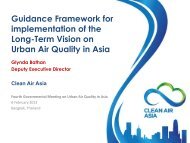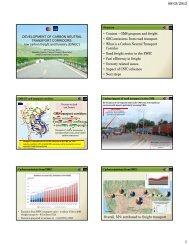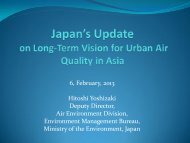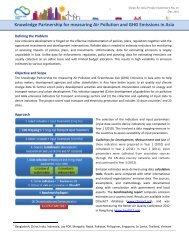International Experience and Best Practices - Clean Air Initiative
International Experience and Best Practices - Clean Air Initiative
International Experience and Best Practices - Clean Air Initiative
You also want an ePaper? Increase the reach of your titles
YUMPU automatically turns print PDFs into web optimized ePapers that Google loves.
In Delhi, four government employees have responsibility for inspecting over 400 PUC<br />
centers, checking that equipment is working <strong>and</strong> that technicians are authorized <strong>and</strong><br />
following proper procedures. 224 However, this constitutes only a tiny step toward true<br />
oversight <strong>and</strong> QA. SIAM has piloted a more sophisticated approach that takes the first<br />
steps toward computerized data entry <strong>and</strong> record keeping. The Mashelkar Committee<br />
has endorsed its adoption.<br />
In principle, there is a rational division of labor among the national <strong>and</strong> state<br />
governments: the national government sets minimum emission st<strong>and</strong>ards <strong>and</strong> equipment<br />
<strong>and</strong> test specifications, <strong>and</strong> state government implements the program with the option of<br />
setting stricter st<strong>and</strong>ards.<br />
Another aspect of institutional design largely ignored in India is the phase-in of I/M,<br />
coupled with constant evaluation <strong>and</strong> evolution. Essentially India set up I/M systems for<br />
all vehicles at once, <strong>and</strong> set st<strong>and</strong>ards that have not tightened over time. It did not set<br />
up means of evaluating performance <strong>and</strong> adapting <strong>and</strong> evolving. The result has been a<br />
stagnant <strong>and</strong> ineffectual I/M system.<br />
C.2.2. Test Procedures <strong>and</strong> Emission St<strong>and</strong>ards<br />
Fleet characterization has been a challenge for Indian policymakers due to the absence<br />
of two key inputs: annual vehicle registration information <strong>and</strong> accurate emissions data.<br />
Vehicles are registered just once when they are new or brought into a new jurisdiction.<br />
Ostensibly, they re-register after 15 years. The lack of accurate records of emissions,<br />
vehicle type, age, etc. means policymakers do not have a solid basis for revising cutpoints<br />
to put pressure on drivers to maintain their vehicles. Efforts by SIAM, USAID,<br />
<strong>and</strong> others described in the preceding chapters should result in better data, but they are<br />
an inferior substitute for the kind of ongoing data collection <strong>and</strong> analysis seen in other<br />
countries.<br />
With regard to test procedures, Delhi <strong>and</strong> other Indian cities have used the most<br />
common no-load tests from the outset: idle emission testing for gasoline vehicles<br />
<strong>and</strong> snap acceleration tests for diesel vehicles. There has been little interest among<br />
policymakers in moving toward loaded testing. In the case of PUC testing, the<br />
institutional design virtually precludes loaded testing–where would the capital come from<br />
for dynamometers? In the case of the I&C system, in theory, the government-operated<br />
test-only centers could switch to loaded testing; but that system appears trapped in a<br />
web of corruption.<br />
Ironically, India has set the toughest emission st<strong>and</strong>ards in the world for new 2&3<br />
wheelers, while its PUC st<strong>and</strong>ards for in-use 2&3 wheelers are among the weakest. The<br />
national government set PUC <strong>and</strong> I&C st<strong>and</strong>ards in 1986 <strong>and</strong> they were not revised or<br />
updated until 2004. For 18 years, three simple st<strong>and</strong>ards applied:<br />
94<br />
• 4.5 percent CO for 2&3 wheelers<br />
• 3.0 percent CO for cars <strong>and</strong> other gasoline vehicles<br />
224 For example, technicians rarely use extension pipes in measuring 2/3 wheeler emissions when there is<br />
a likelihood of dilution of the exhaust stream (Rajat N<strong>and</strong>i, personal communication).


